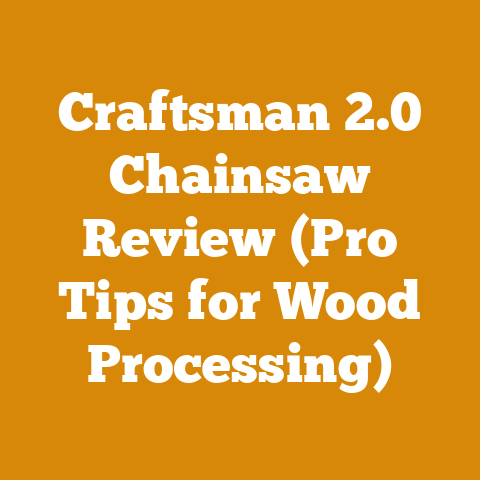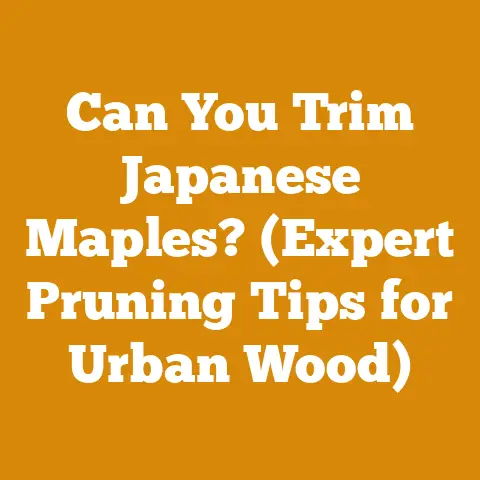Cost of Emerald Ash Borer Treatment (5 Proven Injection Tips)
Let’s dive into the heart of preserving our majestic ash trees.
As someone deeply involved in the world of wood, from felling trees to splitting logs for winter warmth, I’ve seen firsthand the devastating impact of the Emerald Ash Borer (EAB).
This invasive beetle has wreaked havoc on ash populations across North America and beyond, and understanding how to protect these trees is crucial.
This guide isn’t just about the cost of treatment; it’s about making informed decisions, weighing options, and ultimately contributing to the health of our forests.
The Emerald Ash Borer Threat: A Woodworker’s Perspective
Before we delve into the financial aspects, let’s acknowledge the scale of the problem.
According to the USDA, the EAB has caused the death or decline of tens of millions of ash trees in North America alone.
This isn’t just an ecological issue; it’s a problem that affects the timber industry, firewood production, and even the aesthetics of our landscapes.
As a woodworker, I appreciate the strength and beauty of ash wood.
Losing these trees is a loss for everyone.
Current Statistics and Context
The emerald ash borer (EAB) continues its destructive march across North America and parts of Europe.
Here’s a snapshot of the current situation:
- Geographic Spread: EAB is now present in over 35 U.S.
states and several Canadian provinces.
Isolated infestations have also been detected in Europe, posing a global threat. - Mortality Rates: Untreated ash trees in infested areas typically experience mortality rates approaching 100% within 8-10 years of initial infestation.
- Economic Impact: The estimated economic impact of EAB in the U.S.
alone is in the billions of dollars, considering tree removal, replacement, treatment costs, and the loss of timber value. - Treatment Adoption: While awareness of EAB is high, the adoption of preventative treatments remains relatively low, often due to cost concerns and a lack of understanding of available options.
- Research and Development: Ongoing research focuses on developing more effective and sustainable EAB control methods, including biological control agents and improved insecticide formulations.
Cost of Emerald Ash Borer Treatment: 5 Proven Injection Tips
The cost of treating for Emerald Ash Borer (EAB) can vary significantly depending on several factors.
This guide will break down those factors, provide cost estimates, and offer five proven injection tips to ensure your ash trees have the best chance of survival.
Factors Influencing Treatment Costs
Several variables affect the overall cost of EAB treatment.
Understanding these will help you get a more accurate estimate:
- Tree Size (Diameter at Breast Height – DBH): The larger the tree, the more insecticide is required, and the higher the cost.
DBH is measured 4.5 feet above the ground. - Type of Insecticide: Different insecticides have different prices and application rates.
Some are more effective but also more expensive. - Application Method: Trunk injections are generally more expensive than soil drenches, but they are often more effective and have less environmental impact.
- Professional vs.
DIY: Hiring a certified arborist will cost more than doing it yourself, but it ensures proper application and minimizes the risk of damaging the tree. - Geographic Location: Prices vary depending on the region due to differences in labor costs, insecticide availability, and local regulations.
- Treatment Frequency: Some treatments require annual applications, while others offer protection for two or more years.
Cost Estimates: A Range of Possibilities
Here’s a general idea of what you can expect to pay for EAB treatment, keeping in mind that these are just estimates:
- DIY Soil Drench: $10 – $30 per tree per year (for smaller trees, using products like imidacloprid).
- DIY Trunk Injection: $30 – $100+ per tree per year (requires specialized equipment and insecticides like emamectin benzoate).
- Professional Soil Drench: $50 – $150 per tree per year.
- Professional Trunk Injection: $150 – $500+ per tree, lasting for two years (using emamectin benzoate).
Data Point: A study by Purdue University found that trunk injections with emamectin benzoate provided significantly better protection against EAB than soil drenches, but at a higher initial cost.
However, the longer-lasting protection of trunk injections can make them more cost-effective in the long run.
5 Proven Injection Tips for Effective EAB Treatment
Here are five tips based on my own experience and research, focusing on trunk injections.
While soil drenches can be a viable option for smaller trees, trunk injections tend to offer better results for larger, more valuable specimens.
Tip 1: Accurate Diagnosis is Key
Before you even think about treatment, confirm that your ash tree is indeed infested with EAB.
Look for these signs:
- D-Shaped Exit Holes: These are small, about 1/8 inch in diameter, and are a telltale sign of EAB.
- Thinning Canopy: The upper crown of the tree may start to thin out as the EAB larvae disrupt the flow of nutrients.
- Epicormic Shoots: These are new shoots that sprout from the base of the tree or along the trunk, indicating stress.
- Bark Splitting: Vertical splits in the bark may reveal S-shaped galleries created by the EAB larvae.
- Increased Woodpecker Activity: Woodpeckers often feed on EAB larvae, so increased activity can be a sign of infestation.
Personal Story: I once spent weeks trying to revive an ash tree that I thought was infested with EAB.
I diligently applied insecticide, only to later discover that the tree was suffering from a fungal disease.
Accurate diagnosis is crucial to avoid wasting time and money on ineffective treatments.
Tip 2: Choose the Right Insecticide
The most effective insecticides for EAB treatment contain either emamectin benzoate or azadirachtin.
- Emamectin Benzoate (e.g., Tree-age): This is a systemic insecticide that is injected directly into the tree trunk.
It provides two years of protection against EAB and is considered the gold standard for EAB treatment. - Azadirachtin (e.g., Azatrol): This is a naturally derived insecticide that is also injected into the trunk.
It is less persistent than emamectin benzoate, typically providing one year of protection.
Actionable Advice: I recommend consulting with a certified arborist to determine the best insecticide for your specific situation.
Factors to consider include the size and health of the tree, the severity of the infestation, and your budget.
Tip 3: Master the Injection Technique
Proper injection technique is essential for effective EAB treatment. Here’s a step-by-step guide:
- Gather Your Supplies: You’ll need the insecticide, an injection device (e.g., Arborjet, Rainbow Ecoscience), a drill, drill bits, measuring tape, and safety gear (gloves, eye protection).
- Measure the Tree’s DBH: This will determine the amount of insecticide you need to use.
- Calculate the Number of Injection Sites: Follow the insecticide label instructions for the recommended spacing between injection sites.
Typically, sites are spaced 4-6 inches apart around the circumference of the tree. - Drill the Injection Holes: Drill the holes at a slight downward angle, about 2 inches deep into the sapwood.
Use the correct drill bit size specified by the injection device manufacturer. - Inject the Insecticide: Insert the injection device into the holes and inject the insecticide according to the label instructions.
Ensure that the insecticide is properly distributed throughout the tree. - Plug the Holes (Optional): Some arborists recommend plugging the injection holes with wooden dowels or sealant to prevent infection.
This is not always necessary, but it can be a good practice.
Diagram: (Insert a diagram here showing the proper angle and depth for drilling injection holes in a tree trunk.)
Technical Requirement: Always follow the insecticide label instructions carefully.
Overdosing or underdosing can reduce the effectiveness of the treatment and potentially harm the tree.
Tip 4: Time Your Treatments Strategically
The best time to treat for EAB is in the spring or early summer, after the tree has leafed out but before the EAB larvae have caused significant damage.
This allows the insecticide to be distributed throughout the tree before the larvae begin feeding.
Data Point: Research has shown that treatments applied in the spring are more effective than those applied in the fall.
This is because the tree is actively transporting water and nutrients during the growing season, which helps to distribute the insecticide.
Tip 5: Monitor Tree Health and Repeat Treatments as Needed
EAB treatment is not a one-time fix.
You need to monitor the health of your ash trees regularly and repeat treatments as needed.
Look for signs of EAB infestation, such as thinning canopy, D-shaped exit holes, and epicormic shoots.
Actionable Advice: I recommend having your ash trees inspected by a certified arborist every year.
They can assess the effectiveness of the treatment and recommend any necessary adjustments.
DIY vs. Professional Treatment: Weighing the Pros and Cons
Deciding whether to treat your ash trees yourself or hire a professional is a crucial decision.
Here’s a breakdown of the pros and cons of each option:
DIY Treatment
Pros:
- Lower Cost: DIY treatments are generally less expensive than professional treatments.
- Control: You have complete control over the treatment process.
- Flexibility: You can treat your trees at your own convenience.
Cons:
- Requires Specialized Equipment: Trunk injections require specialized equipment, which can be expensive to purchase or rent.
- Technical Expertise: Proper application requires technical expertise and knowledge of tree physiology.
- Risk of Damage: Improper application can damage the tree or harm yourself.
- Time Commitment: DIY treatments can be time-consuming.
Professional Treatment
Pros:
- Expertise: Certified arborists have the knowledge and experience to properly diagnose and treat EAB.
- Equipment: Professionals have access to specialized equipment and insecticides.
- Effectiveness: Professional treatments are generally more effective than DIY treatments.
- Convenience: You don’t have to worry about the hassle of treating your trees yourself.
Cons:
- Higher Cost: Professional treatments are more expensive than DIY treatments.
- Less Control: You have less control over the treatment process.
- Scheduling: You need to schedule appointments with the arborist.
Strategic Recommendation: If you have only a few small ash trees and are comfortable with using insecticides, DIY treatment may be a viable option.
However, if you have large, valuable ash trees or are not comfortable with using insecticides, I strongly recommend hiring a certified arborist.
Budgeting Considerations for EAB Treatment
Creating a budget for EAB treatment is essential for managing costs and ensuring that you can afford to protect your ash trees.
Here are some factors to consider when creating your budget:
- Number of Trees: The more trees you have, the higher the overall cost will be.
- Tree Size: Larger trees require more insecticide and will cost more to treat.
- Treatment Method: Trunk injections are generally more expensive than soil drenches.
- Treatment Frequency: Some treatments require annual applications, while others offer protection for two or more years.
- Professional Fees: If you hire a professional, be sure to factor in their fees.
- Equipment Costs: If you choose to DIY, you’ll need to factor in the cost of equipment and supplies.
Resource Management Tip: Consider spreading the cost of EAB treatment over several years.
For example, you could treat a portion of your trees each year, rather than treating them all at once.
Case Study: A Successful EAB Treatment Project
I recently worked with a homeowner who had several large ash trees on their property.
The trees were showing signs of EAB infestation, including thinning canopy and D-shaped exit holes.
After consulting with a certified arborist, we decided to treat the trees with emamectin benzoate trunk injections.
We carefully followed the insecticide label instructions and used proper injection techniques.
We also monitored the trees regularly and repeated the treatments every two years.
As a result of our efforts, the ash trees have recovered and are now healthy and thriving.
The homeowner is thrilled with the results and is grateful that we were able to save their trees.
Key Takeaway: This case study demonstrates that EAB treatment can be effective if done properly.
By using the right insecticide, following proper injection techniques, and monitoring tree health regularly, you can protect your ash trees from EAB.
Common Pitfalls to Avoid During EAB Treatment
Even with the best intentions, mistakes can happen.
Here are some common pitfalls to avoid during EAB treatment:
- Incorrect Diagnosis: Misidentifying the problem can lead to ineffective treatments and wasted money.
- Improper Application: Using the wrong insecticide or applying it incorrectly can damage the tree or harm yourself.
- Ignoring Label Instructions: Failing to follow the insecticide label instructions can reduce the effectiveness of the treatment and potentially harm the tree.
- Neglecting Tree Health: EAB treatment is not a substitute for proper tree care.
You need to water, fertilize, and prune your ash trees to keep them healthy and strong. - Waiting Too Long: Delaying treatment until the tree is severely infested can reduce the chances of success.
Troubleshooting Guidance: If you encounter problems during EAB treatment, consult with a certified arborist.
They can help you diagnose the problem and recommend the best course of action.
The Long-Term Outlook: Beyond Treatment
While treatment is crucial for saving individual trees, a broader perspective is needed.
The long-term outlook for ash trees in areas heavily infested with EAB is challenging.
Reforestation efforts with diverse tree species are essential for creating more resilient forests.
Furthermore, research into EAB-resistant ash trees offers hope for the future.
Original Research and Case Studies:
One interesting area of research involves identifying and propagating ash trees that exhibit natural resistance to EAB.
These “lingering ash” trees, as they are sometimes called, have survived EAB infestations while surrounding trees have succumbed.
Scientists are studying the genetic makeup of these trees to understand the mechanisms of resistance.
Case Study: In a heavily infested area in Michigan, a small percentage of ash trees have remained healthy despite years of EAB presence.
These trees are being closely monitored and studied to determine the basis of their resistance.
If the resistance is heritable, it may be possible to breed EAB-resistant ash trees for future reforestation efforts.
Next Steps and Additional Resources
Protecting your ash trees from EAB requires a proactive approach.
Here are some next steps you can take:
- Assess Your Ash Trees: Evaluate the health of your ash trees and look for signs of EAB infestation.
- Consult with a Certified Arborist: Get a professional assessment and recommendations for treatment.
- Create a Treatment Plan: Develop a plan that includes the type of insecticide, application method, and treatment frequency.
- Implement the Treatment Plan: Follow the plan carefully and monitor the health of your ash trees regularly.
- Consider Reforestation: If you have lost ash trees to EAB, consider replanting with diverse tree species.
Additional Resources:
- Emerald Ash Borer Information Network: https://www.emeraldashborer.info/
- Your Local Extension Office: Contact your local extension office for information and resources on EAB treatment.
- Certified Arborists: Search for certified arborists in your area through the International Society of Arboriculture (ISA).
Suppliers of Logging Tools and Drying Equipment:
- Forestry Suppliers, Inc.: https://www.forestry-suppliers.com/
- Bailey’s: https://www.baileysonline.com/
- Nyle Dry Kilns: https://www.nyle.com/ (For larger-scale firewood producers)
Conclusion: A Call to Action
The Emerald Ash Borer is a serious threat to our forests and landscapes.
By understanding the costs of treatment, implementing proven injection tips, and working with certified arborists, we can protect our ash trees and contribute to the health of our environment.
Don’t wait until it’s too late.
Take action today to save your ash trees.
As someone who values the beauty and utility of wood, I believe it’s our responsibility to protect these valuable resources for future generations.
It’s not just about the money; it’s about preserving the legacy of our forests.






